No.5  October 2007 October 2007 | ||
 |
Crop Prospects and Food Situation | |
|
Regional reviews
Harvesting of the 2007 winter crops (wheat and barley) has been completed, spring coarse grains (maize and sorghum) are presently being harvested in Egypt and harvesting of paddy is about to start. Aggregate wheat output for the subregion is provisionally estimated at 13.4 million tonnes, 28 percent down from the good crop of 2006 and below average. This is the result of prolonged dry conditions during the cropping season, which adversely affected yields in several growing areas, notably in Morocco where wheat output is estimated to have dropped by 76 percent, the lowest level of the past five years. In Egypt, the largest producer in the subregion, where most of the wheat is irrigated, wheat production is provisionally estimated at 7.4 million tonnes, which is close to the average of the previous five years but 10 percent lower than last year’s bumper crop. The coarse grains crop for the subregion is provisionally estimated at 10.8 million tonnes, about 8 percent below the five-year average.
After erratic and below-average rains until late July, which necessitated replanting in most countries, precipitation increased significantly from mid-July and remained abundant in August and September. Substantial flooding was reported across the subregion with considerable human casualties and damage to crops and livestock in several countries, notably in Ghana, Togo, Burkina Faso, Mali and Mauritania. Cape Verde is the only country where this year’s cereal production is likely to be seriously affected regardless of weather conditions during the rest of the season, due to persistent dry conditions in most producing areas through early September. In spite of the heavy rains and floods, a good cereal production is anticipated in most countries (due to the localized nature of the floods) including in Nigeria, the largest producer in the subregion, whose agricultural sector can strongly affect the food supply position of its neighbouring Sahel nations. The flooding is also expected to have a positive impact on off-season crops across the subregion, by ensuring ample soil moisture reserves.
In Cameroon and the Central African Republic, where rains have been abundant and widespread since the beginning of the cropping season in April, harvesting of the first 2007 maize crop is nearly completed. In the latter country, however, agricultural recovery and food security continue to be hampered by persistent insecurity and inadequate availability of agricultural inputs, notably in northern parts. 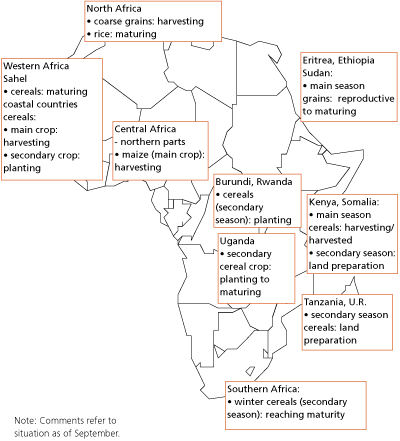
In eastern Africa, harvesting of the 2007 main season cereal crops is complete or is about to be completed in southern parts of the subregion, while in northern parts crops are at varying stages of development. Abundant rains in July and August generally improved the 2007 crop prospects in several countries. However, heavy rains and floods in parts of several countries, mainly Sudan, Ethiopia and Uganda, have killed a number of people and/or displaced thousands, destroyed or damaged crops and increased the likelihood of serious localized food shortages. In Somalia, the worst main cropping “gu” season in thirteen years, disruptions in trade, displacement, high inflation and continued civil insecurity are drastically reducing household food access. The humanitarian situation, especially in the Shebelle Valley, Hiran and Mogadishu regions where households are already extremely food insecure, continues to deteriorate. Cereal production in the current main agricultural "gu" season in southern Somalia was estimated at 48 600 tonnes, representing only 31 percent of the 1995 to 2006 post-war average and 43 percent of last year’s gu production. The number of people in need of humanitarian assistance has increased by 50 percent in the last six months from 1 million to 1.5 million people. Nearly one-fifth of these people are classified in Humanitarian Emergency (HE) requiring life saving interventions while a third are in Acute Food and Livelihood Crisis (AFLC) requiring livelihood support. In addition, there are 325 000 people who are newly displaced from Mogadishu and 400 000 already displaced requiring both life and livelihood saving interventions. In Sudan, heavy rains within the country and in neighbouring Ethiopian and Eritrean highlands caused an overflow of the main rivers. So far, torrential rains and floods have killed some 90 people across Sudan and destroyed more than 70 000 homes. At least 12 000 head of livestock and more than 42 000 hectares of crops are reported to have been destroyed. In addition, more than 200 000 people have also lost their homes and an estimated 3.5 million people are reported to be at risk of epidemics. Worst affected areas include Kassala in eastern Sudan, and parts of Unity and Upper Nile states in the South. The 2007 rainfall season is turning out to be one of the wettest in recent history across many areas of Sudan. The early onset of the season was characterized by very wet June and July conditions, which continued through August. The amount of rainfall has been above average in most parts of the country with more northern regions receiving twice the average rainfall. Harvesting of the 2007 main season crops is expected to start in November. An FAO/WFP Crop and Food Supply Assessment Mission is visiting southern Sudan in October and is planned to visit northern Sudan in November to assess the main season production and estimate food assistance requirements, if any, in 2008. An appeal has been made for US$20 million to support the humanitarian assistance launched by the United Nations following the severe floods. Similarly, in Ethiopia, floods have so far affected more than 130 000 people with an estimated 36 000 of them being displaced in Afar, Amhara, Gambella, Tigray and Southern Nations Nationalities and Peoples (SNNP) regions. Furthermore, as the ongoing rains raise the water level of Lake Tana, there are concerns that more people in the surrounding districts of north-western Ethiopia could be displaced. This year's flooding seems to have also occurred in normally non-flood prone areas, increasing floodwater area coverage. Government and humanitarian agencies’ joint contingency plans anticipate relief and recovery assistance will be required for 324 000 people this season under the most likely scenario. In Uganda, harvesting of this season's maize crop is almost complete and output is estimated similar to last year’s and the average. Floods in August and early September were reported to have displaced hundreds of families and destroyed crops in the eastern parts of the county. The Minister for relief, disaster preparedness and refugees indicated that high waters had submerged entire villages and destroyed many farms. Several communities in Aakum in the Katakwi district, and Acowa in Amuria district, have been affected by the flooding. Neighbouring regions in north-western Kenya have also been affected, with more than one thousand families displaced after heavy rains in the western highlands caused a river to burst its banks and flood villages. In Kenya, harvesting of the 2007 long-rains season maize started in the bi-modal maize growing areas of Nyanza and parts of Western Provinces. The maize crop, for harvest from October, in the main growing province of the Rift Valley is reported to be in good condition. Prospects are generally favourable due to good rains. The long rains cropping season normally accounts for 80 percent of total annual food production. The official forecast indicates a well above average 2007 long-season maize output of about 2.56 million tonnes. In the United Republic of Tanzania, maize harvesting is almost completed in unimodal maize growing areas and the overall food supply situation is adequate following good harvests and improved pastures.
A favourable maize supply position in Kenya, Uganda and Tanzania has resulted in stable maize prices for most of this year (Figure 6). According to the Eastern Africa Grain Council (EAGC), all three countries have surplus marketable maize.However, according to data from the Regional Agricultural Trade Intelligence Network (RATIN), average wholesale maize prices in Tanzania rose sharply in August and September, to more than US$170/tonne, after having remained fairly stable at US$ 120/tonne for most of the year. This compares to US$143/tonne and US$146/tonne for the same period in 2006 and 2005 respectively. In Ethiopia, cereal prices in the last two years remained at much higher levels than previous years despite three consecutive years of good harvests. From January 2004, cereal prices have increased consistently, falling back only slightly after the Meher harvest of 2004. Prices were at record levels in October 2006 and latest observations (Rapid Trader Survey) indicate that the upward trend has continued (Figure 7). In contrast to the usual past trends, there is lack of any significant post-harvest reduction of prices in the last few years. Possible factors behind current price trends, forwarded by recent studies, include: the relatively rapid rise in income, which is being fuelled by the rapid increase in government expenditure, credit (commercial and microfinance), export receipts and transfers in the form of remittances, productive safety net programs (PSNP); the retention of cereal supply by smallholder farmers mainly due to increased cash income from alternatives sources and high prices of farm products (including cereals); and the decline in the amount of food aid distributed in the country. Food inflation, currently estimated at about 19 percent, is, therefore, the highest it has been since 2003. The high rates observed in late 2003 were due to the impact of the drought in 2002. The food security position of large number of vulnerable people, mainly in urban centres, is negatively impacted with these high and rising prices.
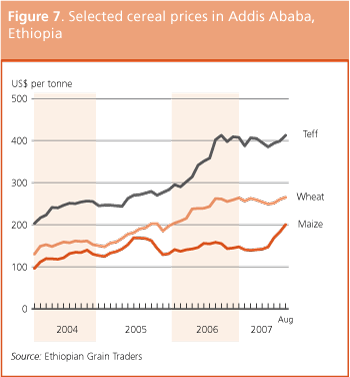
The aggregate 2007 cereal production in the subregion is forecast at 22.7 million tonnes marginally better than last year’s about-average level. Of this, maize is estimated to account for 15.6 million tonnes, some 4 percent higher than last year’s below-average outcome. In South Africa, by far the largest producer in the subregion, final official figures put maize output at 7.1 million tonnes, a slight recovery over last year’s reduced crop, but still about 26 percent below the five-year average, primarily a reflection of drought in the main growing areas (Figures 8 and 9) By contrast, excluding South Africa, the aggregate cereal harvest of the other countries in the subregion is estimated at a bumper level, their total outputs of all cereals and maize estimated to be above the five-year averages by more than one-third and more than one-quarter respectively. However, this masks wide differences in performance in cereal production at the national level. Malawi’s maize harvest is estimated at a historical high, but those of Swaziland and Botswana were record lows. Overall, the total cereal production (including early estimates for small amounts of wheat output of the secondary season currently concluding in a few countries) is estimated to increase in Angola, Malawi, Madagascar and Mozambique, and rise above the five-year average in all cases. By contrast, it is estimated to be down compared to 2006 and the average level in Botswana, Lesotho, Namibia, Swaziland and Zimbabwe. In Zambia the 2007 cereal harvest is estimated to be lower than last year’s bumper outcome but remains well above the five-year average. 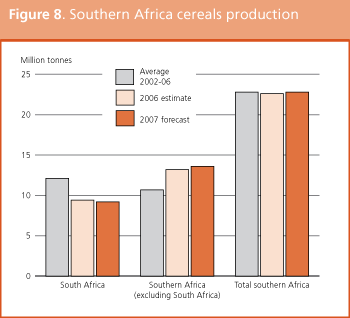
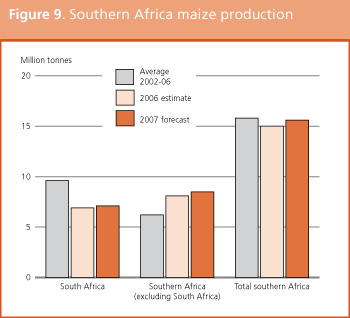
In spite of the bumper aggregate cereal harvest this year at the subregional level (excluding South Africa) the sharply reduced crops in some countries, as well as some expected stock-building, means that the total import requirement of the group is estimated to be slightly higher in 2007/08 than in the previous season, although it would still remain below average.
Maize prices in most countries in the subregion, with the exception of Malawi, have been higher in recent months than during the same period a year ago (Figure 10). Reflecting another below-average harvest maize prices in South Africa have remained consistently higher than the corresponding monthly levels during the past two years and have been steadily rising since April 2007. The Randfontein spot price of white maize, which peaked at R1 965 per tonne (US$271 per tonne) in March 2007, momentarily came down after harvest in April and May, but by August, had risen back up to R1 828 per tonne (US$253 per tonne). SAFEX future’s prices show continuation of this positive trend until March 2008. A comparison of nearby white maize SAFEX prices with that of US yellow maize export prices in the last two years indicates a similar general trend. However, over the last few months South African prices have risen more rapidly than the US export prices. This is partly due to strengthening of the Rand against the US dollar since October 2006. High prices in South Africa, the region’s main exporting country, have affected other dependent markets in the region, especially, Swaziland, Lesotho and Zimbabwe. Elsewhere, prices of maize are above last year’s levels in Mozambique and Zambia despite good harvests this year reflecting tightening regional and international markets. By contrast, in Malawi, a bumper maize harvest has resulted in post-harvest prices being considerably lower than in the past two years. 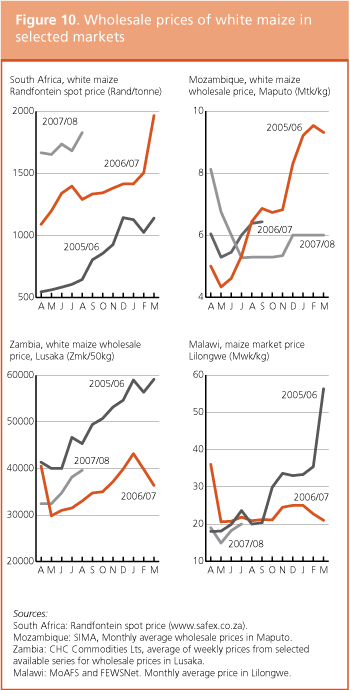
Harvesting of the main rice and maize crops, which make up the bulk of the subregion’s cereal crops, is underway in most countries. Reflecting above–average precipitation throughout the season across most of the subregion, the 2007 aggregate output of rice (paddy) is forecast at a record 579 million tonnes, 3 million tonnes up from the previous high set last year. Production of maize is forecast at some 199 million tonnes, marginally up from last year’s already bumper crop. The subregion’s 2007 wheat crop, which was, gathered earlier in the year, is also estimated at a record level of 206.5 million tonnes, compared to about 199 million tonnes in 2006.
In China (Mainland), the harvest of the 2007 spring wheat crop (the minor wheat crop) was completed in August and output is estimated at some 5 million tonnes, 830 000 tonnes below that of last year as a result of droughts in two major producing provinces - Heilongjiang and Inner Mongolia. However, given the good winter crop gathered earlier, the aggregate wheat output for the year is estimated at a record 107 million tonnes, 2.5 million tonnes above the previous high set last year. Harvesting of the 2007 maize crop was completed in southern areas in August, but is still ongoing in northern China. The 2007 maize output is forecast at 149 million tonnes, virtually unchanged from the record high of last year. Regarding rice, harvesting of the 2007 early crop, a minor crop accounting for less than 20 percent of total annual paddy output, was complete in July, and output is estimated at some 32 million tonnes, about 1 percent above the good crop of last year, reflecting increased use of higher yielding seeds and favourable weather. The intermediate and late rice crops, planted in July, and due for harvest in November and December, are reported to be developing under generally favourable growing conditions, except in some localized area where floods and pest infestations have been reported. The aggregate paddy area in 2007 is estimated almost unchanged from last year and the paddy rice output in 2007 is tentatively forecast at 184 million tonnes, about 1 percent up from last year. Despite the increased level of domestic production in the current season, China is expected to remain a net cereal importer in 2007/08 and could increase its imports to some 3.8 million tonnes from some 2.6 million tonnes in the previous season.
In India, the south-west monsoon was active across the country since the beginning of the season in May and by the end of June resulted in the worst flooding in India for decades, causing loss of life and severe damage to housing, infrastructure and the agriculture sector. Official estimates indicate that close to 18 million people have been adversely affected by the floods, with hundreds of thousands at risk of hunger and disease. In DPR Korea, some 960 000 people directly affected by the floods this season are estimated to be in need of emergency assistance, including food. In several other Asian countries, drought followed by extensive floods have killed a number of people, displaced thousands, destroyed or damaged crops and increased the likelihood of serious food shortages in parts. In Nepal, torrential monsoon rains from mid-July caused severe flooding in southern Terai and landslides in the hill zones. According to the Nepal Red Cross Society (NRCS), more than 21 570 families were displaced, over 26 500 houses were either damaged or destroyed and, overall, some 56 500 families (or 333 000 people) were severely affected by the floods. The most severely hit districts are Kalilali (Far Western Region), Banke and Bardiya (Mid Western Region), and Dhanusa, Parsa and Saptari (Central Terai Districts). In Bangladesh, heavy rainfall since early June resulted in floods and landslides by mid-July killing 400 people, destroying 56 000 houses and partially damaging 700 000. Overall, official estimates indicate that some 10 million persons across 39 districts have been negatively affected by the floods. 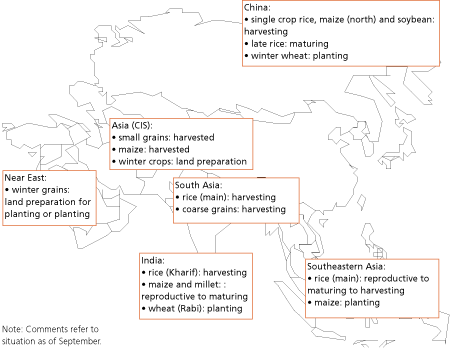
In Afghanistan, despite localized damage from floods and unusually high temperatures during summer and spring, the aggregate cereal harvest is estimated up on the average harvest of the past five years.
In the Asian CIS subregion, aggregate cereal output is estimated at about 30 million tonnes, nearly 300 000 tonnes up on last year’s level. Wheat is the most important cereal crop in the subregion, and is estimated at about 24.3 million tonnes. Aggregate coarse grains output in the subregion is now estimated at 5 million tonnes, some 100 000 tonnes up on last year’s harvest. Kazakhstan is the largest cereal producer in the subregion accounting for more than 53 percent of the total production.
The 2007 aggregate cereal output of the subregion is forecast by FAO at 40.3 million tonnes, about 2.4 million tonnes above the previous year’s level and 3.5 million tonnes above the average of the last five years. In Mexico, harvesting of the 2007 main rain-fed summer coarse grain crops, accounting for some 75 percent of the annual production, is expected to start from late October. Heavy and constant rains in August have caused some floods in coastal areas of northern departments of Tamaulipas and Veracruz, with localized losses of coffee, sugar cane and citrus crops. However, in all major cereal producing areas, moderate to heavy precipitations have maintained favourable moisture levels and early official forecasts point to a record production of coarse grain crops, above 30 million tonnes, with an increase of 7.4 percent from the previous year’s level, mainly as a consequence of an expansion in the areas planted. Land is being prepared for planting the important winter wheat crop for harvest in 2008 in the almost fully irrigated areas of north-western states. Heavy rains at the beginning of September (especially due to the tropical storm “Henriette”) have improved the water level of the main reservoirs. In the other Central American countries, harvesting of the 2007 first season maize crop has been virtually completed and planting of the second season crops, especially beans, has already begun. The outputs are provisionally estimated to be good and the subregion’s 2007 aggregate maize output is expected at 4 million tonnes, an increase of 12 percent from last year.
At the beginning of September, powerful hurricane “Felix” severely hit the northeast Atlantic coast of Nicaragua, affecting the Northern Atlantic Autonomous Region (RAAN) and the departments of Jinotega and Nueva Segovia. It caused losses of lives, and floods and landslides, with significant damage to housing and infrastructure as well as to basic food crops production (mainly second season maize and paddy crops, but also fruit trees such as banana, coconut and mango). Continued flooding and saturated soils may prevent re-planting of maize and paddy crops. More than 32 000 families, mainly indigenous groups, among the poorest and most vulnerable communities in the country, have been affected and are in need of urgent humanitarian assistance to recover their basic livelihood systems. Hurricane “Felix” caused also some infrastructural damage in Honduras, especially in northern departments of Colón, Olancho and Cortés, but losses of cereal crops are officially reported to be minimal. At the same time, heavy rains have improved soil moisture in southern departments of Choluteca and Valle that were affected by poor rainfall distribution in June and July, with significant losses of first season food crops. In the Caribbean, the passage of hurricane “Dean” in mid-August considerably affected agriculture production in Jamaica, Saint Lucia, Martinique and Dominica with up to 100 percent losses of food and cash crops. In these countries, a decreased availability of food and cash crops like bananas, tubers, cocoa, coffee and vegetables is expected in the coming months, most likely accompanied by rising prices in local markets. Nonetheless, in Haiti, the Dominican Republic and Cuba, the abundant seasonal rains were in general beneficial for yields of the main food and cash crops and production is estimated from average to above-average levels. 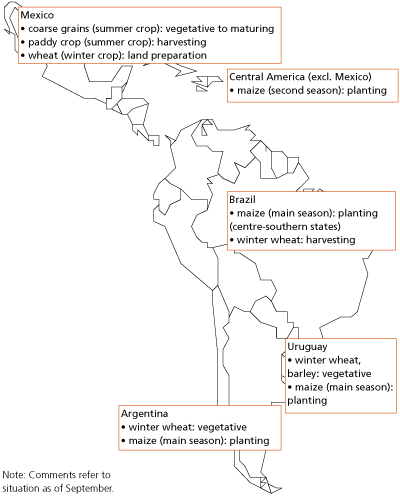
Prices of basic staple food in most countries of the subregion have showing a steep upward trend (Figure 11). Prices of wheat, maize and rice have increased between 30 and 100 per cent in less than 12 months, as a consequence of high international cereal prices, coupled with sustained domestic demand. The situation is expected to adversely affect food access of the poorest households who are highly dependent on purchased food. 
Harvesting of the 2007 winter wheat crop has recently started in centre-south states of Brazil. By the end of October, the harvests are expected to start in the important growing areas of Argentina, Uruguay and Paraguay. Aggregate wheat production for the subregion is tentatively forecast slightly above 21 million tonnes, an about average crop and 7 percent above the previous year’s reduced output, when production was negatively affected by unfavourable weather conditions in several producing countries as well as by reduced plantings in Brazil. Harvesting of the 2007 second season maize crop has been recently completed in the subregion and the 2007 aggregate production (first and second season) is confirmed to be at a record 83.6 million tonnes, well above the five-year average of 65.3 million tonnes. This extraordinary result is due to an increase in the area planted in response to high international prices, coupled with excellent weather conditions during the growing season that boosted yields to record levels. In particular, the 2007 maize output in Brazil, the main producer in the subregion, is officially estimated at 52.2 million tonnes, about one-quarter above the good level obtained in 2006.
Planting of the important 2008 summer maize crop is underway in southern countries of the subregion. Limited soil moisture is delaying planting operations in Argentina, Chile and Uruguay; additional precipitations are needed in the next weeks in order to fulfil national planting programmes. At sub-regional level, it is expected that the area planted with 2008 maize crop will continue to increase, responding to higher prices and greater profitability compared with soybean. The 2008 area planted is expected to exceed 21 million hectares, with an increase of about 7-8 percent on 2007. Assuming a return to average yields after the record levels achieved in 2007, the aggregate 2008 maize crop production is tentatively forecast between 76 and 78 million tonnes.
The current high level of international wheat prices is raising concern in all Andean countries where production bread, the basic staple, heavily depends on imported wheat flour. In Ecuador, the Government has authorized imports with no levy for wheat and wheat flour from Argentina in order to control local price of bread. In Bolivia, the Government has empowered the national army to run some industrial bakeries to produce bread at affordable prices for the most vulnerable population. In Peru, the price of imported wheat has increased by 50 percent since the beginning of the year with resulting increases in the price of bread: the local Bakers Association has proposed the adoption of “bread-coupons” with the aim to subsidize bread for the poorest families.
The United States’ 2007 wheat output is officially estimated to have increased by almost 17 percent compared to the previous year, to 57.5 million tonnes. A sharp expansion of planted area and mostly favourable weather contributed to raise output from the below-average harvest in 2006, although adverse weather in some major growing areas during the spring limited the crop from reaching its earlier potential. As of mid-September, planting of the winter wheat crop for harvest in 2008 was underway in several states. In the northwest, progress was reported to be ahead of average but behind average in the Great Plains, where rains have caused some interruptions to fieldwork, and where much attention was still on the harvest of the large maize crop. However, the rains will have been beneficial to the winter wheat crops that are already in the ground. Good precipitation in previously dry parts of the southern Corn Belt has also been beneficial in improving soil moisture conditions for the winter wheat planting there, which is due in late September and October. Based on current market indications, which point to a very tight wheat supply situation in 2007/08 and continuing strong prices, it is expected that the area planted to winter wheat in the United States could increase further from last year’s already above-average level. In early September, the USDA announced that is was considering the release of land from the Conservation Reserve Programme (CRP), which could potentially help to boost production in 2008, should farmers take up on the offer and plant wheat on the released area. With regard to coarse grains, as of mid-September, harvesting of maize was well advanced in southern parts but just 14 percent done across all the main producing states as a whole. This year’s maize crop is now officially forecast at its highest ever level of almost 338 million tonnes, about 27 percent above the average of the past five years. The increase reflects the largest sown area in several decades, in response to exceptionally strong domestic demand for maize-based ethanol production, and near record yields expected.
The forecast for the European Union’s aggregate cereal output in 2007 has been reduced significantly since the previous report in July, to 263 million tonnes, 2.5 percent down from the aggregate output of the 27 countries in the previous year. Yield prospects deteriorated during the summer in some of the large producers in northern Europe due to adverse summer weather (dryness followed by excessive rain), and in southeast Europe because of persisting exceptionally hot and dry conditions. The bulk of the wheat crop has already been harvested and latest estimates put output at 123 million tonnes, the lowest production since the severe drought-affected year of 2003. The countries with the largest weather-related wheat losses are Bulgaria and Romania in the southeast, where outputs fell to 35 percent and 45 percent below the five-year average respectively, due to drought and extreme hot temperatures. The major northern producers France and Germany report yields that are below those of last year and the five-year average due to summer dryness and wet conditions at harvest, although the latter are likely to have had more impact on crop quality rather than quantitatively. Regarding coarse grains, the EU’s maize crop has also been badly hit by the drought in the south-eastern countries, which account for a large share of the production. The outputs in Hungary and Romania are forecast are about 40 percent and 70 percent below their five-year average. Contrary to the situation for wheat and maize, outputs of barley, rye and oats are all forecast to increase slightly this year. However, the increase (especially for barley), comes largely from Poland and Spain, virtually the only major EU producers that have had generally satisfactory 2006/07 growing seasons. The winter cereal planting for crops to be harvested in 2008 is already well underway in the main northern/western producing countries, under generally satisfactory weather conditions so far. In the southeast, some good rainfall in mid-September, although hampering the still ongoing 2007 harvests was extremely beneficial for the winter cereal prospects there, given the very low levels of soil moisture after the dry summer. Given the current market conditions of tight supply and strong prices, assuming satisfactory autumn weather throughout the main producers, it is very likely that the winter grain area will increase further in the 27 member countries for next year's harvest. In late September the EU removed the 10 percent obligatory set-aside for the 2007/08 season, which could bring up to an estimated 3 million hectares of land back into production.
In the European CIS (The Russian Federation, The Ukraine, Belarus and Moldova), aggregate cereal output in 2007 is now estimated at about 113 million tonnes, some 6 million tonnes down from last year’s already relatively poor harvest. This year’s production was limited partly by reduced planting and partly by lower yields as a result of exceptionally hot and dry weather during much of the spring and summer. The worst affected countries were Moldova and Ukraine. In Ukraine, the spring barley plantings were reduced as a result of heavy rains at planting time in early spring, but then subsequent hot and dry conditions, which set-in for most of the remainder of the spring and summer comprised yields of all the crops. Latest estimates put the total cereal output in 2007 at 28.4 million tonnes, well below last year and about 15 percent below the five-year average. In Moldova, the effect of drought was even more devastating, cutting the total cereal harvest by nearly 60 percent compared with the average of the past five years (see box for details). The Russian Federation, the largest producer in the group, was the least affected by the adverse conditions afflicting the subregion during the season, partly because some major producing areas of the country were not affected by the drought, which was mostly restricted to south-eastern parts of Europe, and partly because the drought was not as severe as in the more southern parts around the Black Sea. Aggregate plantings and yields in the country were close to the recent average and total cereal output is estimated to rise marginally this year compared to 2006 and the average. Planting of winter grains for harvest in 2008 is already underway in parts of the subregion. Early indications in Ukraine point to a larger area being sown, but the level of soil moisture in eastern, southern and some central parts remains unfavourable dry after the long summer drought, which will impair emergence and early development unless good rains arrive soon.
As the winter cropping season in Australia has progressed, exceptionally dry conditions in many major producing parts have significantly reduced the yield potential of the developing crops. The official wheat crop forecast released in early September has been reduced sharply from previous expectations, which had been very favourable given the good conditions at planting, and the increased area sown. The latest forecast now stands at 15.5 million tonnes, down some 30 percent from the forecast in June. However, if materialized, this output will still represent an almost 60 percent increase from the severely drought reduced crop in 2006, when dry conditions plagued virtually the whole of the season. Despite the drier than normal winter, many of this year’s crops at least have the advantage of some residual soil moisture from the planting period to carry them through the critical spring growth period. The early outlook for the minor summer grain crop for harvest in 2008 (mainly sorghum and maize) to be planted in the coming weeks suggests a partial recovery from last year’s sharply reduced crop is possible but output will nevertheless be far below the five-year average. Despite generally low soil water reserves, the main summer crop growing areas have received some timely rainfall for planting, while price incentives for sorghum in particular are expected to encourage farmers to increase the area of this crop. 
|
||||||||||||||||||||||||||||||||||||||||||||||||||||||||||||||||||||||||||||||||||||||||||||||||||||||||||||||||||||||||||||||||||||||||||||||||||||||||||||||||||||||||||||||||||||||||||||||||||||||||||||||||||||||||||||||||||||||||||||||||||||||||||||||||||||||||||||||||||||||||||||||||||||||||||||||||||||||||||||||||||||||||||||||||||||||||||||||||||||||||||||||||||||||||||||||||||||||||||||||||||||||||||||||||||||||||||||||||||||||||||||||||||||||||||||||||||||||||||||||||||||||||||||||||||||||||||||||||||||||||||||||||||||||||||||||||||||||||||||||||||||||||||||||||||||||||||||||||||||||||||||||||||||||||||||||||||||||||||||||||||||||||||||||||||||||||||||||||||||||||||||||||||||||||||||||||||||||||||||||||||||||||||||||||||||||||||||||||||||||||||||||||||||||||||||||||||||||||||||||||||||||||||||||||||||||||||||||||||||||||||||||||||||||||||||||||||||||||||||||||||||||||||||||||||||||||||||||||||||||||||||||||||||||||||||||||||||||||||||||||||||||||||||||||||||||||||||||||||||||
| GIEWS | global information and early warning system on food and agriculture |